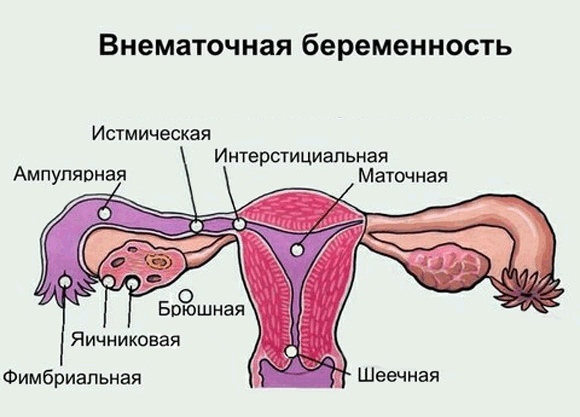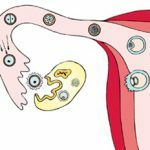Virtually any bloody discharge from the vagina of a woman used to call menstruation. However, this often does not correspond to the truth. The greatest number of doubts and mistakes are associated with the smear after the already occurred fertilization. How to distinguish between menstrual period and pregnancy? After all, remembering well, almost every woman can tell a story when a future mother finds out about her intra-uterine child only in the fifth month or even later.
Causes of "monthly" at different times
It's sometimes difficult to distinguish monthly from dykes during pregnancy, especially in the early stages. More often questions and mistakes arise in women with an irregular, long or short cycle.
In the classical representation, conception is possible only on days 13 - 15 with a 28-day cycle. But in reality, the process of ovulation is influenced by many factors: stresses, the emotional state of women in recent times, the regularity of sex life, body weight and its fluctuations, acute viral diseases, medication. The list is very large, sometimes it is difficult to predict the actions of your own organism. Therefore, the release of the egg from the ovary occurs often at the beginning, end, or generally several times in one month. It is in such situations that a woman can be confused and try to independently distinguish the beginning of the months from pregnancy.
Late ovulation
When the egg yield is shifted towards the end of the cycle, on days 21-25 after fertilization, it does not have time to implant into the mucous membrane of the uterine cavity. But hormonal changes are already beginning to occur in the body of a woman. Under the influence of these events, the endometrium is still rejected.

Early ovulation
Being engaged in open sex in the last days of menstruation, you can also get a conception in the end. Allocations in this case can continue more than usual, and the woman takes them for usual critical days.
Multiple ovulation
Sometimes, especially with the abolition of oral contraceptives, several eggs emerge from the ovary, simultaneously or at a certain interval. One option is repeated ovulation at the end of the cycle, at the beginning of the menstrual period. Then with open sexual contact, the probability of pregnancy is high. But critical days will also be, perhaps, a bit unusual.
Female genital anomaly
Not so rare there are such deviations in the standard structure of the pelvic organs, as doubled uterus and bicorn, the septum in the cavity is complete or incomplete. With this development, the body behaves a little differently than in the classical sense. The fertilized egg is implanted in one part, for example, in the right or left horn. At this time, menstrual-like changes occur in another, the endometrium is rejected, but only in this area. So it can last several months, and a woman will not even suspect that she is pregnant. To distinguish signs of conception from symptoms of menstruation in such a situation is difficult: because in one place the embryo develops, and next to the usual cyclic changes in the endometrium.
Implantation allocation
Normally, the embryo can enter the uterine cavity not immediately, and its implantation - insertion into the endometrium prepared for this, occurs then for 14 to 21 days. These days, there may be bloody and brown discharge from the genital tract, something reminiscent of critical days.

Non-developing pregnancy
For various reasons, fading may occur at different times - from 3 to 4 to 35 -38 weeks. This is due to genetic abnormalities of the embryo, women's somatic and gynecological diseases, the presence of infections, as well as environmental factors. The most "dangerous" period in the early days are the days of the expected menstruation. At this time the body of a woman experiences the greatest hormonal fluctuations. In the case of an undeveloped pregnancy, bloody discharge may appear, the intensity of which may vary.
Ectopic attachment of the egg
If there is an obstacle in the way of migration of the fertilized egg through the tubes to the uterus, its attachment may occur in the wrong place. Most often it is a uterine tube, less often - the area near the ovary or he, the cervix, even the intestine and peritoneum. At some point, the part of the organ where the "donkey" embryo is damaged, intraabdominal bleeding of different intensity occurs. To distinguish symptoms of pregnancy from monthly symptoms in such a situation is difficult: there are pulling pains in the lower abdomen, as if "just about to go the secretions," and then a dark brown daub appears.

The threat of termination of pregnancy
This is the most common cause of all discharge during pregnancy throughout its length. Usually a woman begins to be bothered by aching, sometimes cramping pains in the lower abdomen. Then there may be bloody discharge - from smearing brown to very plentiful, sometimes with clots. The threat of termination of pregnancy can also be caused by injuries, especially in the abdomen and lower back.
It should also take into account the fact that during the period of breastfeeding a child, conception can occur without menstruation. In such situations, the first released egg immediately fertilized. Then, when there is a threat of interruption, a daub run begins, and the woman believes that this is a monthly one.
Disruption of chorion implantation processes
Sometimes even at a short term the chorion( the future baby's place) migrates and is implanted into that part of the uterus where it immediately leads to the development of pathology. It is customary to call this "low" and "central" placenta, and in later terms - the central, marginal placenta previa. Even in the absence of provoking factors, suddenly and without any precursors, bleeding can often begin at night with such pregnancy. In most cases, this is an abundant discharge.
Genetic abnormalities and malformations of the embryo
If there is any deviation in the development of the future baby, nature as it tries to protect the woman from the birth of the child with serious, often incompatible with life, vices. It is manifested by periodic sudden bleeding from the genital tract. In the absence of treatment, spontaneous abortion occurs in most cases.
Sexual contacts, smear extraction
During the gestation due to a special hormonal background, the structure of all tissues of a woman changes. This is especially noticeable in the genital area. They are filled with venous blood( therefore cyanosis during examination), easily injured. Even the standard procedure for taking smears, especially from the cervical canal, can contribute to the development of a small bleeding. And the longer the gestation period, the more often there are secretions.
Excessive sexual contact can cause trauma to the cervix, especially if the woman has erosion, ectopia, decidual or normal polyp in the canal, as well as another pathology of this area. As a result, there may be discharges, often minor. Unusual poses during sex, gross and awkward movements can even lead to the threat of termination of pregnancy.
Other diseases
Concerned about the process of bearing a baby, a woman sometimes does not have time to understand the source of bleeding. And even for a short period of time, hemorrhoidal nodes may appear, and with minor injuries, it can be hemmed. At the same time, scarlet drops remain on the linen, which leads to perplexity and anxiety of the future mother. As the circumference of the abdomen increases, the pressure in the abdominal cavity increases, which contributes to the progression of the phenomena of hemorrhoids, which can often be damaged.
How to determine: monthly or bleeding?
To distinguish monthly from washing during pregnancy is not always easy on your own. Therefore, in case of suspicion, it is better to consult a specialist who will accurately establish the cause, determine if the allocation represents a threat to the woman.
Symptoms and symptoms that will indicate the occurred conception, which means that it is not at all "monthly":
- When carrying out the pregnancy test, two strips, even if one of them is weakly expressed( this indicates a short term).
- The blood test for HCG shows a fairly high level( the study can be done already from the tenth day after the alleged "productive" sexual contact).
- In the chart of basal temperature of 37 degrees does not fall on a background of delay of monthly or their unusual character( daub or, on the contrary, very abundant).
- Nausea and vomiting appear, especially in the morning and for a certain meal.
- Drawing pains in the lower abdomen and lower back. And for menstruation is often characterized by pain before the onset of discharge, while during pregnancy each new attack entails increased bleeding.
- Often after conception, the girl marks swelling of the mammary glands, and, as a result, an increase in them by 1 - 3 sizes. Nipples and areoles can also begin to hurt.
The nature of the discharge is different from the standard monthly."For" the fact that fertilization has occurred, says:
- Lean smearing brown discharge. Sometimes it's just one small drop of blood.
- Sometimes the consistency and color reminds water with veins of blood.
- Allocations begin after a delay. The more days of "overdue", the more likely the pregnancy.
- Non-standard beginning of "menstruation" for this girl. For example, if usually the critical days were preceded by pains in the lower abdomen, and now they are not, and the blood appeared suddenly. Or vice versa.
What to do with mom
The most important thing is to stay calm. It is important to understand that "monthly", i.e.bloody discharge during pregnancy should not be. This is a complication in bearing a child, with a rare exception( for example, a small smear after taking swabs from the cervix).
Algorithm of actions:
- It is necessary to try to remember all possible provocative moments for the beginning of bleeding. Perhaps the day before was a sexual act.
- If the discharge is minor( smearing the character), the abdomen and lower back do not bother, then you should perform a small pelvic ultrasound and apply for an appointment with a gynecologist in the near future in a planned manner.
- If the bleeding is bright pink, abundant, you should immediately call an ambulance or get to the nearest hospital with a gynecological hospital on your own transport.
- Also, with cramping pain and spotting, seek medical help immediately.
- In no case with strong pains and heavy "menstruation" do not need to stand in line and wait for reception! This is an emergency, reception without coupons and out of turn.
With timely and effective treatment, the safety of mom and baby is beyond doubt in most cases. But even if conception does not occur, profuse, painful discharge still requires a doctor.

 We recommend reading the article on spotting ovulation. From it you will learn about the physiology of the female body, the reasons for the appearance of secretions, as well as whether to go to a gynecologist.
We recommend reading the article on spotting ovulation. From it you will learn about the physiology of the female body, the reasons for the appearance of secretions, as well as whether to go to a gynecologist.